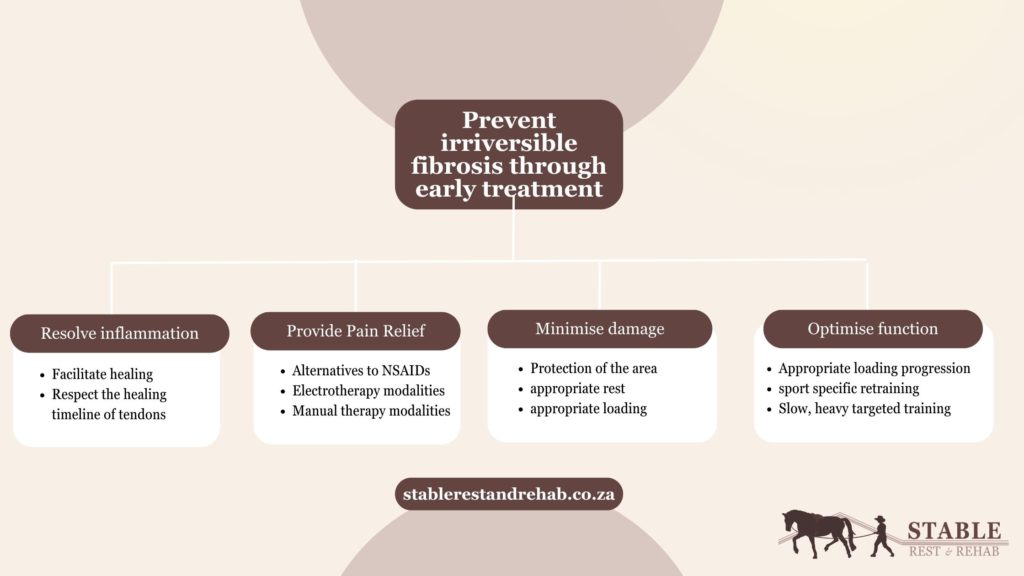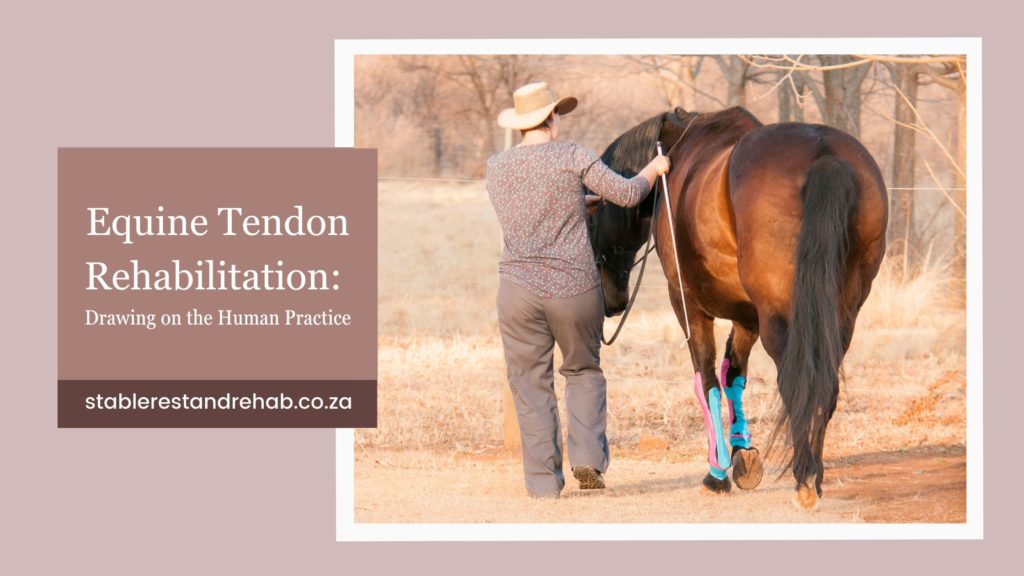Tendon rehabilitation and the available literature has advanced dramatically within the human industry over the last 20 years. Staying ahead of these developments can help us to continue to improve equine tendon rehabilitation programs, strategies and techniques.
While equine tendon rehabilitation remains frustrating and challenging, deepening our understanding of tendon anatomy, healing processes and rehabilitation protocols can help us to improve the quality of rehabilitation programs created for equines.
Let’s look at some of the ways that human literature is shedding light on equine rehabilitation.
Understanding tendons and their function
The anatomy and structure of the human and equine tendon are similar, although different tendons will have different energy storage capabilities. Tendons are by nature elastic, and they behave like springs that store and release energy during movement. This is excessively valuable to the horse as a prey animal, as the energy storage capacity of the tendons allows horses to conserve and maximally utilize the energy that they consume through their diet.
Tendons are enclosed in a sheath that allows them to slide. Some tendons will have a load applied to them only in a straight line, while others will have a straight and compressive load applied to them as they travel around a bone, joint or other structure.
Tendons provide valuable shock absorption during high-impact movements, and can allow the muscle to lengthen at a lower eccentric velocity – this protects the muscle from injury.
Tendons are made up of proteins known as collagen. In general, we refer to type I, II and III collagen, but there are actually 20 known types of collagen in the body – WOW! Tendons are primarily made up of type I collagen, and will usually heal with type III collagen. Tendons also contain glucosaminoglycans, elastin and extracellular matrix. Cells known as tenocytes are responsible for synthesizing collagen and are therefore cells we want to consider during the healing process.
Tendons have a wave form when they are not under load, which allows the tendon to lengthen by simply straightening out the waves. These fibres then have an additional level of stretch available to them after the fibres have straightened out.
Tendon Injuries
A tendon injury, or tendinopathy is characterized by pain and dysfunction of a tendon, and it can include tears, ruptures, pain and a loss of function of that structure. Tendons are well known for their poor ability to heal, the extended period of time that it takes for them to heal, and of course for their high risk of re-injury.
Pain in Tendons
Pain within a tendon can occur in the presence or absence of tendon pathology or tissue damage and is initiated by an excessive load. Pain pathways are modulated in several ways – both locally where the injury occurs, within the spinal cord, and within the brain. When tendon pain becomes chronic, these pain pathways may start to adapt to the pain. This means that they become better able to transmit pain signals, and in essence, the horse’s perception of pain will become heightened over time.
During the rehabilitation of human tendon injuries, immediate pain sensation during loading is something that practitioners will encourage their patients to accept and ignore. What is more important in guiding exercise progression, is their level of pain over a 24-hour period after loading. This approach does pose some challenges to us as equine rehab therapists, as ethically we do not want to cause pain in our horses, nor do we want to encourage them to work despite any pain they may be experiencing.
However, pain perception is usually not an accurate reflection of the actual damage to the tendon, and unfortunately, without adequate loading (and a degree of pain), we are unlikely to achieve adequate healing of a tendon.
The Differences in Imaging Protocols
Imaging is a very interesting subject to compare between the human and equine fields of tendon rehabilitation, as we have very different approaches. Within human practice and literature, imaging has been shown to poorly reflect the actual damage to the tissue, the prognosis of tendon healing, and the amount of pain a patient is experiencing.
In fact, a fully functioning tendon may have a high degree of abnormal remodelling and fibre alignment in people. For these reasons, imaging is not used as a way to diagnose and monitor the progression of tendon healing over time.
In the equine industry, imaging remains one of the best ways we can monitor the progression of the patient, and regular imaging is an integral part of a tendon rehabilitation program.
Why do Tendon Injuries Happen?
In humans, tendinopathies are more common than arthritis! It occurs more often in adults over 40, in endurance runners, or in inactive adults over 60. Changes in the loading of the tendon are considered to be a large contributing factor – for example when the kind of activity that an individual participates in suddenly changes or increases in intensity.
Tendinopathies can either occur suddenly in the case of a rupture or gradually over a period of time as micro-damage to the tendon occurs.
Early Treatment Intervention
Prevention of tendon injuries is our primary goal, but in the case of an injury, we want to prevent the development of fibrosis or excessive scarring within the tendon, which will further weaken the tendon and increase the risk of future injury.
We can do this through early intervention, diagnosis and treatment. Early treatment aims to resolve (not stop) inflammation, minimize damage to the tendon, optimize the function of the tendon and provide pain relief. This sounds simple, doesn’t it? We will dive further into how we achieve these goals in another post.

A note on NSAIDs
In human medicine, NSAIDs are no longer recommended or used during the rehabilitation of tendon injuries, as they switch off the inflammatory process. Without inflammation in the tendon, healing can’t occur – the inflammatory process kickstarts healing through a multitude of processes. In humans, there are many alternative methods of controlling pain. Unfortunately in horses, there aren’t alternatives to NSAIDs. This puts us in a tricky position. Pain management is non-negotiable, but are we inhibiting the tendon’s ability to heal while we are bringing pain under control?
Going Beyond the Tendon
Rehabilitation of the tendon must go further than a laser focus on only the affected structure. We must consider the changes that occur within the nervous system and muscle recruitment patterns as a result of a tendon injury (or perhaps these changes were a part of the original cause of injury), if we want to effectively rehabilitate the HORSE.
We also need to carefully consider the kind of exercise and loading that we are putting the tendon through, as too low loads will not stimulate adaptation and healing, while too high loads will inhibit healing and lead to further damage to the tendon. More on this to follow 😊
The Bottom Line
Tendons remain difficult to treat and have a high incidence of re-injury. They take many months to heal, and the rehabilitation programs can be time and energy intensive for owners. When we take a scientific approach, we can incorporate rest, loading and rehabilitation strategies that are most likely to be successful, streamlining and optimizing the healing process as much as it is possible to do so for such an injury.

